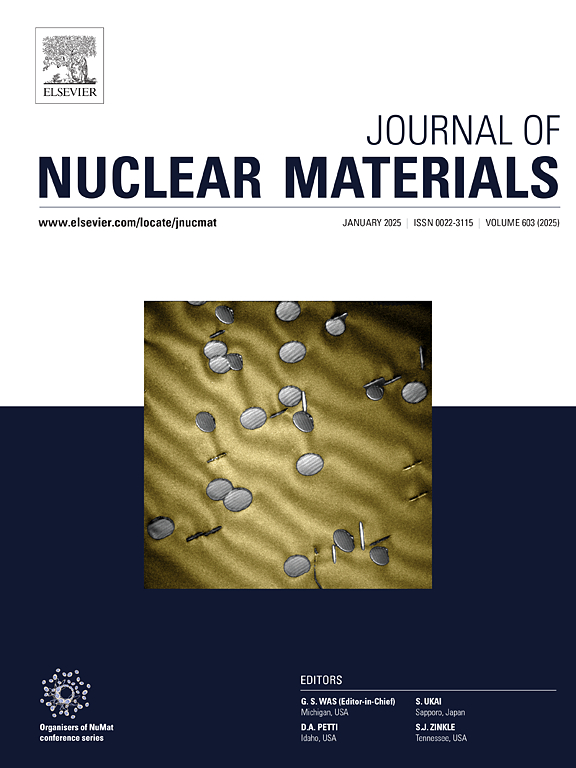A new model of fission gas bubble growth and mechanism analysis for U-xZr fuels
IF 2.8
2区 工程技术
Q3 MATERIALS SCIENCE, MULTIDISCIPLINARY
引用次数: 0
Abstract
U-xZr alloys have a promising application prospect in advanced nuclear fuel elements, and their macroscale volume growth under the extreme service environments are attracting more attention. In this study, innovative volume growth modeling and mechanism analysis are performed for various U-xZr alloys under different operation conditions. Specially, based on the creep test results in the references, the macroscale thermal creep models are newly developed for solid U-xZr alloys within a temperature range, implicitly reflecting the effects of phase fraction; for the bubble contained region of equivalent spherical fuel grain, the established thermal creep models are involved in the mechanical constitutive relations for the solid fuel skeleton; the finite element equations are derived for the displacement fields of bubble contained region and numerically implemented, obtaining the multi-level variables of macroscale volume growth, the local porosity and the average porosity. The predictions of irradiation swelling for different U-xZr alloys agree well with the experimental data at 743 K or 903 K; the fast-swelling phenomena due to various thermal creep contributions could be captured, demonstrating the progressiveness of the developed new models and algorithms. The numerical simulation results indicate that: (1) under the irradiation temperature of 603 K or 703 K, dislocation creep mechanism of fuel skeleton is dominated, due to higher internal and external pressure differences; (2) at the high temperatures of 803 K and 903 K, the thermal diffusion creep deformations of fuel skeleton contribute dominantly to the macroscale volume growth of U-xZr alloys over the whole irradiation process; (3) under zero external pressure the sharp increase phenomena of fission gas swelling become more and more distinct with the rise of irradiation temperature, stemming from the quickened diffusion of fission gas atom and the enhanced creep deformations of fuel skeleton; at 903 K the fuel skeleton is prone to creep deformation, leading to significant inhibition of bubble growth by a small external pressure. This research provides important theoretical models and algorithms for simulation of the irradiation-induced thermo-mechanical behaviors in U-xZr-based fuel elements or assemblies.
求助全文
约1分钟内获得全文
求助全文
来源期刊

Journal of Nuclear Materials
工程技术-材料科学:综合
CiteScore
5.70
自引率
25.80%
发文量
601
审稿时长
63 days
期刊介绍:
The Journal of Nuclear Materials publishes high quality papers in materials research for nuclear applications, primarily fission reactors, fusion reactors, and similar environments including radiation areas of charged particle accelerators. Both original research and critical review papers covering experimental, theoretical, and computational aspects of either fundamental or applied nature are welcome.
The breadth of the field is such that a wide range of processes and properties in the field of materials science and engineering is of interest to the readership, spanning atom-scale processes, microstructures, thermodynamics, mechanical properties, physical properties, and corrosion, for example.
Topics covered by JNM
Fission reactor materials, including fuels, cladding, core structures, pressure vessels, coolant interactions with materials, moderator and control components, fission product behavior.
Materials aspects of the entire fuel cycle.
Materials aspects of the actinides and their compounds.
Performance of nuclear waste materials; materials aspects of the immobilization of wastes.
Fusion reactor materials, including first walls, blankets, insulators and magnets.
Neutron and charged particle radiation effects in materials, including defects, transmutations, microstructures, phase changes and macroscopic properties.
Interaction of plasmas, ion beams, electron beams and electromagnetic radiation with materials relevant to nuclear systems.
 求助内容:
求助内容: 应助结果提醒方式:
应助结果提醒方式:


